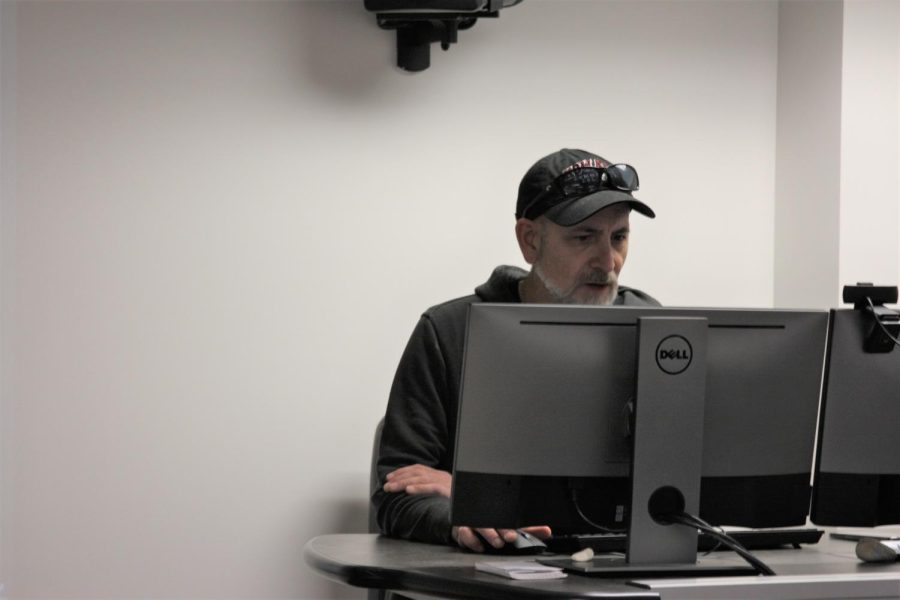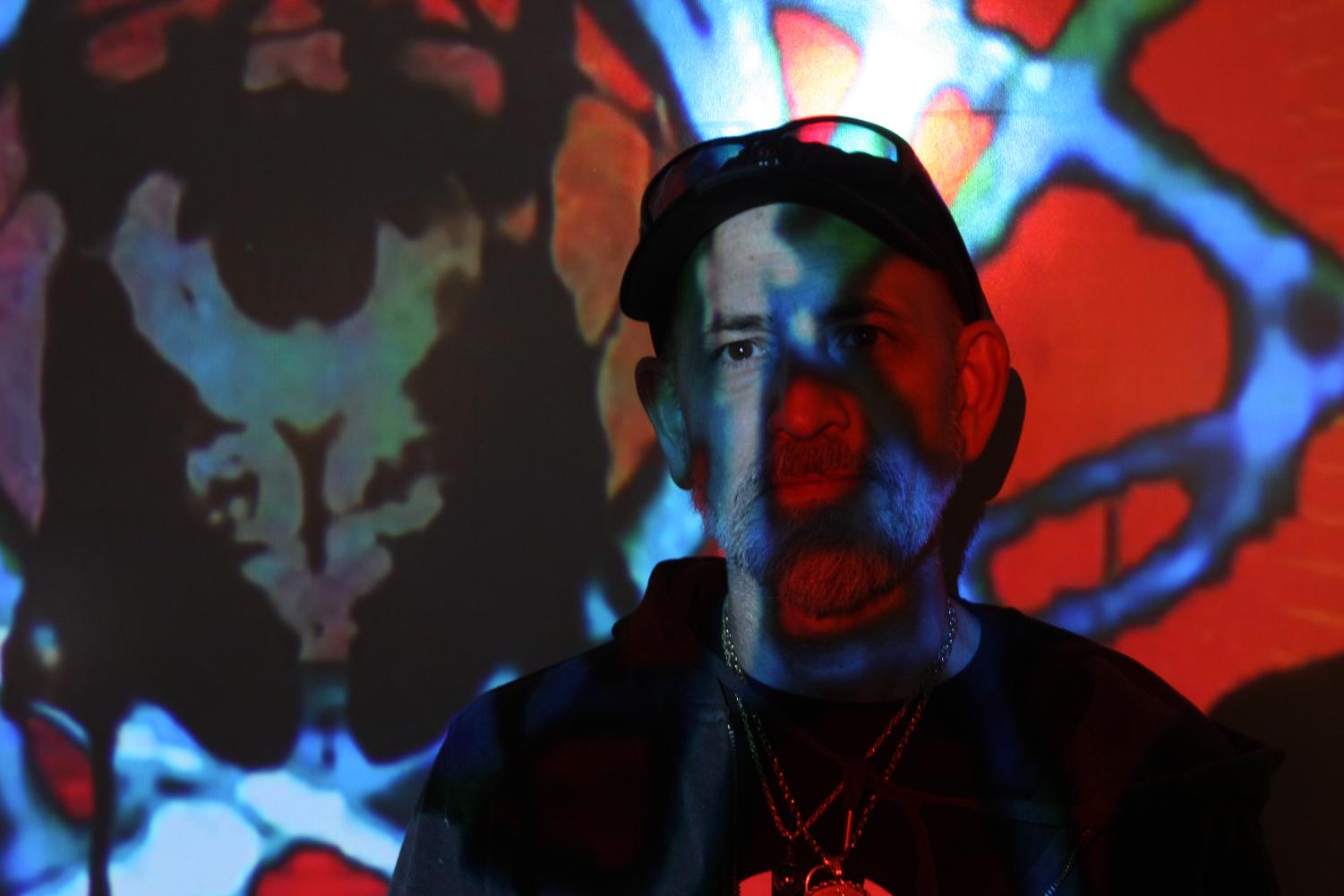A Few Frames of Patrick Pagano
The digital, the divine and the possible future of media collide within the works of HCC Professor Patrick Pagano.
May 11, 2023
The gallery laid behind a glass entrance with black paper sealing the images inside. When entered, multi-colored projections bombarded the viewer with images, set in perpetual loop, but changing every day or week. On one, early in the gallery’s run, a woman could be seen forever diving into a motley ocean. On another, a man turned to snap a photo of the viewer, amid other images like a soaring dragon or the melting of a film strip. Messing with the dials and levers on one device in the corner would change the colors or multiply the looping images or make new ones appear entirely. Throughout the whole run, an ambient droning could be heard, like the creaks of electronics or the chants of monks—a holy sanctum ruminating on the divine within the digital.
This was “PICTOMANCY,” a gallery that ran for much of the past semester, and was developed by Patrick Pagano, a professor in HCC’s audio-visual media production department. It was rather apt for the professor himself—a combination of technical know-how with artistic possibilities, with a touch of religious contemplation and a look toward what may come of media in the future.
“For me, I’ve always said I was an artist seduced into technology,” Pagano said.
Pagano arrived at Howard Community College from the University of Connecticut, where, as a visiting professor, he taught areas like interactive web design, projection design and interactive storytelling among others. He even held a TEDx Talk while teaching.
Pagano’s time at the college was rather short-lived, however, as he said it “wasn’t the right fit,” and so he looked to find a new college to teach at. In 2018, after two years at UConn, he was suggested by friends to look in the Baltimore area for new teaching work and found Columbia.
“I love Columbia,” Pagano said. “I think Columbia is beautiful. It’s really, you know, kind of a nice place to live.”
And so, Pagano has been working at HCC for the past five years. On campus and Zoom, he teaches technical aspects of filmmaking and electronic media, such as audio production. His coursework also extends beyond to more broad concepts or new concepts, with classes like “Intro to Electronic Media” exploring what new virtual technology has to offer.
“I truly believe in community colleges,” Pagano said, saying how he appreciates how these organizations grant more opportunities to people who may not have been able to afford them otherwise. “I think that’s what HCC is about. It’s a cut above because people care, you know. And people want there to be this kind of a place where you can come and get a good education and start your career, knowing that people care. And I think that’s important.”
Yet while teaching has been a long career for Pagano, his work as an artist is just as extensive, if not more so.
On his website, designed by him, Pagano boasts numerous achievements in various areas. On one page, he says that he can play a number of instruments, including sitar, synthesizer and clarinet, and how he once performed with renowned Indian classical composer Ravi Shankar. On another, Pagano lists numerous events he was involved with, going from video art installations to hip hop performances. One page mentions an upcoming book, covering the history of Pure Data, a software language used in multimedia works.
“PICTOMANCY” itself used video projections from previous performances while touring with musicians, when Pagano worked under the artist name HumansNeedLumens, which he still does to this day.
“I consult on rock and roll tours,” Pagano said. “I make special content for performing artists that use my software live on stage, like Bon Iver. And I usually work under an NDA, so you won’t see my name, which is fine by me.”
At the core of these careers, both in art and in academics, is this marriage of media with the advancements of technology. Many of Pagano’s projections or audio pieces make use of generative art—music, visuals or other media made through digital technology, formed through specific inputs or the will of randomness.
“Generative music is what we used to call ‘computer-assisted composition,’ where you could use a computer to choose parameters,” Pagano explained. “I program Markov Chains, where you can create an array of notes. So, say, instead of C-E-G, I want C-E-G-A-E. Then the computer uses a random distribution, and then you can have a computer instrument play it.”
How was Pagano reeled in? Part of it may come from his relationship with religion, or at least a sense of spirituality. Pagano says he follows Sufism, a sort of Islamic mysticism which seeks to experience a direct connection with God through various rituals. At the same time, he has a deep connection with the religions of the Indian subcontinent, whose music he spent 20 years studying. “PICTOMANCY” itself was described as an “ephemeral hierophany,” acting as a “re-combination of the visual source materials acquired and subjected to a neo-magical divination process.”
Within digital technology, Pagano sees these elements of the divine and can manifest them in some form. Aspects of Hindu meditation, like the Yantra, a diagram with a point, or “Bindu,” which the meditator stares at, inspired his projections.
“In Hindustani culture or in my faith, that’s called the Bindu,” Pagano explained. “And in digital media, we call it a pixel. It’s the smallest point. And if you focus on the smallest point, and you realize all of the image are made from these points, there it is. We think we’re separate, but we’re really all one.”
Yet beyond this spiritual connection, Pagano seems to have a genuine fascination for the potential of technology within art, and its rapidly growing use and evolution in art. In particular, he has a keen interest in how the greater accessibility of digital tools and recent innovations in this technology has the potential to change the landscape.
“I love technology because I feel it’s a liberator,” Pagano said. “Technology has a power to blow up power structures, you know. To liberate, to inform, and to democratize things.”
Even as the rise of technology has created certain modern problems, Pagano acknowledged, he also noted that technology has granted more people the ability to create than ever before. The ability to film, cut and distribute a movie has been cheaper than it ever was in human history, limited only by time, skills and the occasional quality of the equipment, which is only improving. The web and digital media also offer new possibilities in interactivity and how we experience a medium. Not just through video games, but also through vast databases like wikis or complex projects like alternate reality games. All of this offers heavy questions for both distributors and artists themselves on what these new technologies mean for them.
One of the most recent (and controversial) examples of art integrating with technology is AI art and writing. Conjuring vast databases of artwork to generate whatever image or text the user wishes from a simple prompt, these technologies may offer new or perhaps more efficient ways in creating artwork for people. Pagano, as someone with a keen interest in the availability of art tools and in generative art, expressed a hopefulness for its potential.
“I think it’s neat,” Pagano said. “Think of it as computer-assisted art.” He compared its use to that of sampling seen in the ‘80s and ‘90s, where numerous pieces of audio from songs and media would be remixed to create entirely new works. “This is the RZA sampler [or the] J Dilla sampler of video art or, you know, image art. Taking something that exists, like old records or whatever, and recontextualizing them into a new context and having something come out of it.”
Of course, this has been met with controversy. Part of it comes from questions of ownership and the legal basis: AI art compiles from vast indexes of works and media, and many artists feel that the use of their hard work without permission or compensation is unfair or even unlawful. Wider existential questions also persist. What does it mean when the visual creative process is pushed through an algorithm by a prompt, rather than by the development of skills and vision for details? Could that still be replicated with AI art? Or any artistic works, for that matter? And what would that imply for art consumption overall?
Pagano for his part seems rather incredulous about the idea of ownership, or at least the idea that credit comes before creation.
“Back then, people didn’t care about this idea of ‘ownership,’” Pagano said. “It was about the idea of process [and] innovation. Now everybody’s hung up on ‘Oh, well who owns it?’ and ‘Oh, are you giving credit to the photographer?’ And I’m like, no? When someone covers a song, you’re supposed to know the song. Not [mimicking a musician], ‘Oh, hey, this one’s from 1847. It’s a sea shanty that sailors sang on their way to a prison in whatever, you know. And here we go.’ People don’t care about that. They want to know ‘Does it sound good?’ ‘Is it pretty?’ ‘Does it speak to my heart?’”
Of course, predicting the future is always a fickle thing, so whether all AI art or virtual reality or so on may truly be a sea change or not, only time will tell. For now, though, Pagano is ready to teach what he knows to potential visionaries here at HCC. Preparing them for this brave new world, or at least expanding their minds a bit.
“It’s really quite fun for me to share with people artists that they will absolutely love that they’ve never heard of before, you know?” Pagano said. “And that’s still one of those joys of teaching—sharing what you know is something this person needs or will appreciate. And it’s not a kind of social media ‘Check it out!,’ you know? It’s just ‘Hey, you’re gonna dig this.’ And [if] they do or they don’t, it doesn’t really matter. But when they totally do, that light goes on, and that joyful feeling. And they start to find their own footing in the language. That’s where innovation and new ideas happen. I think that’s the joy of teaching.”


![20230415_113954[1]](https://hcctimes.org/wp-content/uploads/2023/05/20230415_1139541-900x506.jpg)